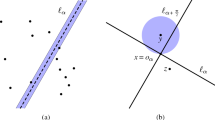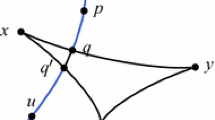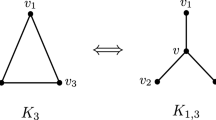Abstract
The chromatic number of a family of solid balls is the minimum number of colors necessary to color the balls so that mutually tangent balls have different colors. A cycle of solid balls is a cyclic sequence of balls in which each consecutive pair of balls are tangent. A cycle of balls is called knotted if the closed polygonal curve obtained by connecting the centers of consecutive balls with line segments is knotted. (a) How large the chromatic number of a family of balls can be? (b) How many balls are necessary to make a knotted cycle? These problems are considered for (1) a general family of balls, (2) balls all sitting on a table, (3) a general family of unit balls, (4) unit balls lying between a pair of parallel planes at distance ρ + 2 apart. This paper gives a survey of the current state of arts including some original new results.
Similar content being viewed by others
References
Adams, C. C.: The Knot Book. Freeman, New York (1994)
Bezdek, K.: Sphere packings revisited. Eur. J. Combin. 27, 864–883 (2006)
Brightwell, G., Scheinerman, E.: Representation of planar graphs. SIAM J. Discrete Math. 6, 214–226 (1993)
Coulson, D.: A 15-coloring of 3-space omitting distance one. Discrete Math. 256, 83–90 (2002)
Maehara, H., Noha, H.: On the graph represented by a family of solid balls on a table. Ryukyu Math. J. 19, 51–64 (1997)
Maehara, H., Oshiro, A.: On knotted necklaces of pearls. Eur. J. Combin. 20, 411–420 (1999)
Maehara, H., Oshiro, A.: On knotted necklace of pearls and Simon’s energy. Yokohama Math. J. 47, 177–185 (2000)
Maehara, H., Oshiro, A.: On Soddy’s hexlet and a linked 4 pair. In: J. Akiyama et al. (eds.) JCDCG 1998, LNCS vol. 1763, pp. 187–193 (2000)
Maehara, H., Oshiro, A.: Arranging solid balls to represent a graph. Graphs Comb. 18, 343–365 (2002)
Maehara, H.: Pearl numbers versus stick numbers for knots. Rev. Roumaine Math. Pures Appl. 51, 49–56 (2006)
Nechushtan, O.: On the space chromatic number. Discrete Math. 256, 499–507 (2002)
Ogilvy, C. S.: Excursion in Geometry. Oxford University Press, New York (1969)
Pach, J., Agarwal, P.K.: Combinatorial Geometry. Wiley, New York (1995)
Shelah, S., Soifer, A.: Axiom of choice and chromatic number of the plane. J. Comb. Theory A 103, 387–391 (2003)
Soifer, A., Shelah, S.: Axiom of choice and chromatic number: example on the plane. J. Comb. Theory A 105, 359–364 (2004)
Soifer, A.: Axiom of choice and chromatic number of Rn. J. Comb. Theorey A 110, 169–173 (2005)
Thurston, W.: The Geometry and Topology of Three-Manifolds. Princeton Lecture Notes. Princeton University Press, Princeton (1985)
Author information
Authors and Affiliations
Corresponding author
Rights and permissions
About this article
Cite this article
Maehara, H. On Configurations of Solid Balls in 3-Space: Chromatic Numbers and Knotted Cycles. Graphs and Combinatorics 23 (Suppl 1), 307–320 (2007). https://doi.org/10.1007/s00373-007-0702-7
Received:
Accepted:
Issue Date:
DOI: https://doi.org/10.1007/s00373-007-0702-7




